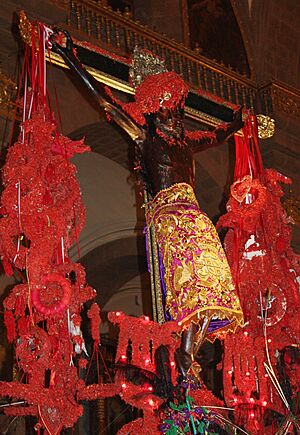Señor de los Temblores facts for kids
The Señor de los Temblores is a famous statue of Jesus on the cross. In the Quechua language, it's called Taytacha Temblores, which means "Lord of the Earthquakes." This statue is from the late 1500s and is kept in the Cusco Cathedral in Cusco, Peru.
Many people believe this statue helped protect Cusco during a big earthquake in 1650. Because of this, Taytacha Temblores became known as the patron saint (a special protector) of Cusco. Every year on Holy Monday, the statue is carried through the city in a special parade. It's one of the most well-known sculptures in Peru today, and you can see it in many paintings.
Contents
History of the Statue
The original statue of the Señor de los Temblores was likely made in the Cusco area around 1570. But there are also popular stories about how it came to be.
Stories About Its Arrival
One story says that King Philip II of Spain heard that people in Peru were still worshiping their old gods. So, he ordered a special statue of Christ to be made. This statue was different from others in Spain. It was made to have a copper color and features that local people could recognize.
This statue was then sent by ship to Peru, landing at the port of Callao. From there, it was supposed to go to Cusco. But near its destination, in a place called Mollepata, the box holding the statue became so heavy that no one could move it! People believed this meant the statue wanted to stay in Mollepata, so it was left there. The person transporting it then asked a local artist to make a copy. This copy was taken to Cusco and placed in the cathedral.
Another story talks about three statues being sent from Spain. When people in a town called Inkillpata heard about the statue that stayed in Mollepata, they asked for one of the other statues to stay with them. The transporter agreed. So, he arrived in Cusco with only the last statue. This statue was stored away until the terrible earthquake of 1650.
How It Was Made
Even with these stories about its Spanish origin, experts now believe the Señor de los Temblores statue was made locally in Peru. A study in 1978 showed how it was created.
First, the sculptor made a basic shape using straw. Then, layers of glued cloth were added over the straw. Once dry, the straw was removed, making the statue hollow inside. Only the hands and arms have wooden parts, as they help support the statue.
Historian Pedro Querejazu added more details. He said that the arms have a wooden piece inside that reaches the body. The main shape was covered with small, carved pieces of maguey wood. The final details were then added using plaster paste.
What the Statue Looks Like
The Señor de los Temblores statue is made from different materials. These include sticks, pieces of agave plant fiber, and plaster.
Its Unique Color
The statue's black color is not how it looked originally. It became black over hundreds of years from smoke and dust. This came from candles and oil lamps used near it. Also, red ñuk'chu flowers are showered on the statue during its procession on Holy Monday. The pollen and color from these flowers have also stained its surface.
During recent efforts to fix and strengthen the statue, its surface was not cleaned. However, its structure was made stronger, and any damage from insects was repaired.
Materials and Features
The sculpture has unusual features and an uneven shape. For a long time, people thought it was made from llama skin, with a hollow body and not much artistic value. But during a restoration in 1985, artists found out the body was not made of animal skin. It was made from linen, a plant fiber. The head is made of maguey wood, and the feet and hands are made of balsa wood. These are all common materials found in the Andean region. This is why the Taytacha de los Temblores is now considered a truly local and original work of art.
Adornments and Changes
The Christ statue is carefully decorated. The nails on its hands and feet are made of pure gold and have precious stones in them. It used to have a heavy crown of pure gold with stones, weighing 1.3 kilograms. This was a gift from a Spanish leader named Viceroy Francisco de Borja y Aragon. Sadly, this crown was stolen in the 1980s. The crown it wears now is also gold, but it is lighter. Over time, statues of the Virgin of Sorrows and St. John the Evangelist were added to the altar with the Señor de los Temblores.
Gallery
See also
 In Spanish: Señor de los Temblores para niños
In Spanish: Señor de los Temblores para niños
- List of statues of Jesus



